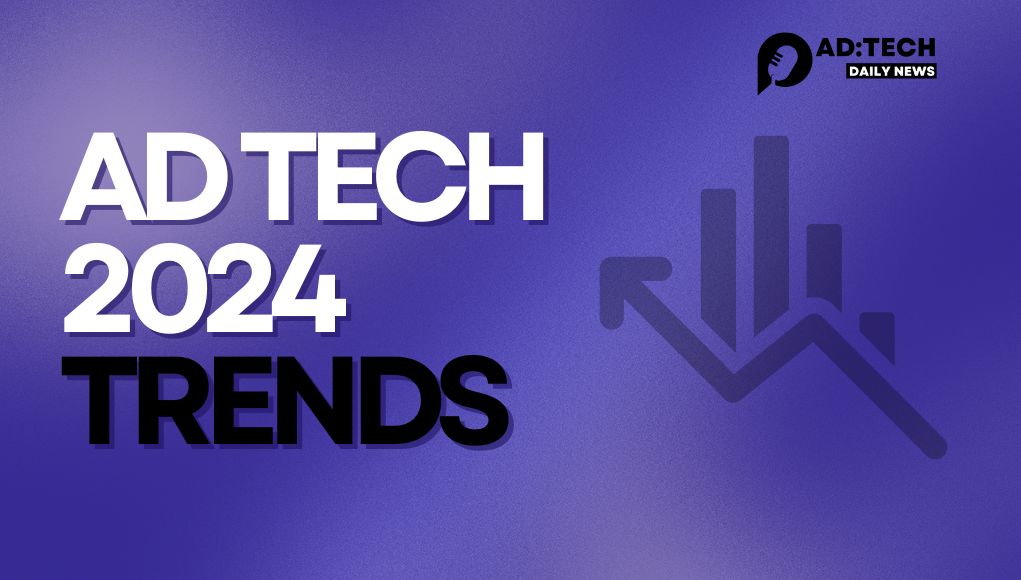Adtech 2024 Trends
As we explore the changing world of Adtech, a big question comes up: Can old marketing ways still work in a world full of digital ads? The year 2024 is bringing new innovations and trends that will change the future of marketing. These changes, like using data and making content personal, are key for marketers who want to keep up. This section will show how advertising tech is changing and why it’s vital for brands to connect with their audience.

Key Takeaways
- The importance of adapting to the changing landscape of advertising technology.
- Emerging trends are shaping consumer interactions with brands.
- Data-driven marketing strategies are becoming more crucial than ever.
- Personalization will play a key role in enhancing customer experiences.
- Staying informed about industry insights can provide a competitive edge.
Understanding Adtech: An Overview
In today’s fast-paced marketing world, advertising technology, or adtech, is key to digital advertising success. It’s important to understand what adtech is. Adtech includes tools, platforms, and methods to send ads to the right people.
The shift in digital advertising has changed how we reach people and use technology. Old ways are now replaced by data-driven methods. This change has brought new players into the adtech world, like:
- Ad networks
- Demand-side platforms (DSPs)
- Data management platforms (DMPs)
These tools work together to make ads more effective. For example, demand-side platforms help advertisers buy ads in many places. This means better targeting and campaign optimization. Data management platforms use consumer data for personalized ads.
Staying updated with the latest research is crucial in adtech. Sources like the Interactive Advertising Bureau (IAB) and eMarketer offer deep insights. Their studies help us understand what makes digital ads work.
| Adtech Components | Function |
|---|---|
| Ad Networks | Connect advertisers with publishers to facilitate the buying and selling of ad space. |
| Demand-Side Platforms | Allow advertisers to purchase media in an automated fashion, optimizing ad buys. |
| Data Management Platforms | Enable advertisers to collect, organize, and analyze consumer data for targeted advertising. |
Knowing about adtech helps us adjust our strategies to stay ahead. As we dive deeper into this field, understanding these basics will help us in the future of digital advertising.
Key Adtech 2024 Trends
As we step into 2024, several adtech trends are set to change digital marketing. Advanced targeting and automation are becoming key for brands to make ads more effective.
One big trend is using consumer behavior analytics. This lets marketers understand what people like, making ads more personal. By using big data, brands can make their ads hit the mark with the right people.
Brands are changing how they market to use these new trends. Better targeting means more people engage with ads and buy more. With new tools, companies can focus on campaigns that work best.
Automation is also changing how ads work. Machine learning helps adjust ads on the fly based on how well they’re doing. This keeps marketing teams ahead in a fast-changing world.
Looking ahead, staying on top of these adtech trends in 2024 is key for marketing success. The mix of tech and creativity will change how we connect with people and tell our brand stories.
Emerging Technologies in Adtech
In the world of adtech, emerging technologies are key. AI in advertising is changing the game, making marketing better for brands. Now, with advanced algorithms and data insights, advertisers can reach their audience more effectively.
Impact of Artificial Intelligence in Advertising
AI has changed how brands talk to consumers. It offers personalized recommendations and analyzes data for better targeting. This leads to higher engagement rates. Companies using AI see big jumps in conversion rates.
By studying consumer behavior, brands can tweak their campaigns on the fly. This keeps their ads relevant and interesting.
The Role of Machine Learning Algorithms for Advertising
Machine learning is crucial in adtech for understanding market trends. These algorithms look at huge amounts of data to spot patterns. They help advertisers make smart, data-driven choices, boosting ROI.
Machine learning makes advertising more efficient and gives insights for better ad performance over time.
Programmatic Advertising: What to Expect
The world of programmatic advertising is always changing. Looking ahead to 2024, we see big changes coming. New technologies and strategies will make the future of programmatic advertising bright. This will bring new chances for marketers and advertisers.
Future Developments in Programmatic Buying
Real-time bidding will grow, letting advertisers quickly decide based on what people like. This means ads will hit the right audience at the perfect time. We’ll also see more cross-channel programmatic strategies, making ads work better across different digital places.
Reports say up to 80% of digital display ads will be programmatic by late 2024. This shows brands need to jump on this trend fast.
Benefits of Automated Ad Buying Processes
Automated ad buying brings big wins for marketing. The main perks are:
- Increased Efficiency: It makes buying ads faster, cutting down on mistakes.
- Real-Time Analytics: Advertisers get data right away, helping them make smart choices.
- Greater Customization: Automated systems make ads fit what users like better.
- Cost-Effectiveness: It helps save money and boosts return on investment by placing ads better.
As programmatic advertising keeps evolving, adapting is key to staying ahead. We expect more growth that will make automated ad buying even better. This will push the future of programmatic into new areas.
The Shift Towards Data-Driven Marketing Strategies
Today, we see a big move towards using data in marketing. Brands use first-party, second-party, and third-party data to make their ads hit the mark. This focus on data helps marketers send messages that really speak to their audience, boosting engagement and sales.
Analytics have changed how we check how ads are doing. With real-time data, we can see what works and what doesn’t with our audience. This helps us keep making our marketing better, making it more effective over time.
Tools like Google Analytics and HubSpot are key in this shift. They let us dig deep into customer behavior, showing us what they like to buy and why. With this info, we can make our marketing smarter, hitting our audience harder.
Experts like Gartner say data-driven marketing is on the rise. They predict that brands using data will do better than those sticking with old ways. Using data is not just a trend; it’s a big change towards smarter ads.
| Type of Data | Description | Usage in Campaigns |
|---|---|---|
| First-Party Data | Data collected directly from your customers | Personalized experiences and targeting |
| Second-Party Data | Data from a partner company that is valuable for targeting | Expanded audience reach and insights |
| Third-Party Data | Aggregated data from external sources | Broader market analysis and segmentation |
Personalized Advertising in 2024
Looking ahead to 2024, personalized advertising is set to change the game. It lets brands speak directly to people by matching messages with their likes and needs. This shift in ad personalization is key to getting people more involved and building strong brand loyalty.
How Personalization Enhances Customer Experience
Today, customers want brands to get personal. Personalized ads hit the mark by offering content that speaks to them. This approach boosts satisfaction and ups conversion rates. By using data to predict what customers want, brands build deeper connections. This leads to more loyal customers and bigger sales.
Best Practices for Implementing Personalized Campaigns
For successful personalized ads, planning is key. Here are some top tips:
- Utilize customer data: Use insights from past interactions and what they’ve bought to make ads that hit the mark.
- Segment your audience: Group customers by who they are or what they like to make ads more relevant.
- A/B testing: Test different personalized messages to see which ones work best with each group.
- Feedback loops: Ask customers what they think and tweak ads based on their feedback to do better next time.
Getting the hang of personalization can really boost our marketing. Brands like Amazon and Netflix show how it can keep customers coming back for more.
| Personalization Tactic | Benefits | Example Brand |
|---|---|---|
| Behavior Tracking | Increases relevance of ads | Amazon |
| Email Personalization | Improves open rates | Netflix |
| Retargeting Ads | Boosts conversion rates | eBay |
Digital Transformation in Adtech Industry
The adtech industry is changing fast, thanks to digital transformation. This change is not just about new ads but also about big shifts in marketing strategies. Now, businesses can make ads that hit the mark better thanks to new digital tools.
How Digital Transformation is Changing Marketing Strategies
Thanks to digital transformation, companies can connect with customers in new ways. They use data and tech to make ads that speak directly to people. For example, social media lets marketers quickly adjust their plans to match what people want.
Big companies are seeing big wins by using adtech innovation. They’re seeing more sales and happier customers. The key changes include:
- Automation: Making campaign management easier saves time and boosts efficiency.
- Data Utilization: Using customer data helps make smarter choices and target ads better.
- Enhanced analytics: Strong analytics tools help understand what customers like, leading to better marketing.
Digital transformation is key to updating marketing strategies. It helps businesses stay ahead in a fast-changing world.
| Company | Digital Transformation Strategy | Outcome |
|---|---|---|
| Amazon | Investing in advanced AI for personalized recommendations | Increased sales conversions and customer retention |
| Coca-Cola | Implementing data-driven advertising on social media | Enhanced engagement and brand loyalty |
| Netflix | Leveraging big data to recommend content effectively | Higher viewer satisfaction and reduced churn rate |
Blockchain in Adtech: The Future of Transparency
The use of blockchain in digital ads is changing the game for better ad transparency. This tech changes how data is managed, making it safer and more accountable for everyone. It helps fight ad fraud and protect user data, making ads more trustworthy.
Benefits of Blockchain for Advertisers and Publishers
Blockchain offers more than just transparency. Advertisers get a secure way to track their ads. Publishers can protect their content with blockchain’s strong security. Here are the main perks for both:
- Enhanced Tracking: Blockchain lets you track ad performance in real-time. Advertisers see exactly where their money goes.
- Increased Trust: Immutable records help advertisers check if their ads are shown where they should be. This builds trust between brands and platforms.
- Reduced Fraud: Blockchain cuts down ad fraud chances a lot, a big issue in the industry.
- Transparent Metrics: Everyone gets clear data on ad performance. This leads to fair deals and better partnerships.
Adding blockchain to adtech makes the whole process more efficient and trustworthy. It changes how we see digital marketing by making everything clear and accountable.
Creative Adtech Solutions for 2024
In 2024, digital marketing will change a lot thanks to creative adtech solutions. Brands are looking for new ways to grab attention and connect with people. They’re using adtech creativity, which mixes tech skills with artistic ideas.
Campaigns using augmented reality and interactive ads are showing how this trend works. These ads make users more involved, letting them try out products in new ways. TikTok is also a key place for brands to make short, catchy ads that work well with their goals. This leads to more people taking action.
Experts say it’s key for creative teams and data analysts to work together. This way, brands can make their messages hit the mark while still being creative. By using data, they can keep their ads fresh and effective.
- Innovative advertising reflects a brand’s personality, making it relatable and engaging.
- Use of storytelling in ads creates an emotional connection with the audience.
- Interactive elements in ad campaigns encourage participation and sharing among users.
We’ve talked to creative directors to learn more about this trend. They say combining creativity with technology is key. As adtech grows, we’ll see more marketing that really speaks to people.

Measuring the Effectiveness of Adtech Tools
It’s crucial to know how to check our adtech tools for success. We must focus on measuring ad effectiveness with key metrics. These metrics help us make better choices and improve our campaigns. By looking at these numbers, we can do better in the future.
Key Metrics to Monitor for Campaign Success
To see how well our campaigns work, we should watch a few important numbers. Here are some key campaign success metrics to look at:
- Click-Through Rate (CTR): Shows how often people click on our ads compared to how many times they see them.
- Conversion Rates: Tells us the percentage of users who do what we want them to after seeing the ad.
- Return on Investment (ROI): Helps us see if our campaigns make money.
- Customer Lifetime Value (CLV): Figures out how much money a customer will bring in over time.
- Cost Per Acquisition (CPA): Tells us how much it costs to get one customer.
Using tools like Google Analytics helps us do a deep dive into ad performance analysis. With this data, we can spot trends, see what’s working, and what’s not. This helps us make our ads better for the next time.
| Metric | Definition | Importance |
|---|---|---|
| CTR | Percentage of clicks on the ad compared to impressions | Shows if the ad grabs attention and is relevant |
| Conversion Rate | Percentage of visitors who do what we want them to | Tells us if the ad gets people to take action |
| ROI | Ratio of net profit to the cost of the campaign | Shows if ads are profitable overall |
| CLV | Predictive value of the customer over their entire relationship | Helps us understand how profitable a customer will be over time |
| CPA | Cost incurred to acquire one customer | Helps with budgeting and understanding marketing costs |
The Importance of Privacy and Compliance in Adtech
In 2024, the focus on privacy in advertising is more critical than ever. Brands are changing their ways to meet strict compliance regulations. This shift is due to growing worries about data safety and user privacy.
Laws like the GDPR in adtech and the California Consumer Privacy Act (CCPA) set tough rules for advertisers. These laws make it clear how businesses must handle user data. They also give users more control over their personal info.
To meet these rules and still reach our audience, brands need to follow best practices. This includes:
- Setting up clear ways to get user consent about how data is used.
- Using anonymous data to lower risks linked to personal info.
- Checking data management often to follow the rules.
Putting privacy first helps build trust with users. It also leads to ads that fit today’s values. Knowing and following the complex rules helps us make a system that supports both sticking to the law and good marketing.
| Regulation | Focus Area | Key Requirement |
|---|---|---|
| GDPR | Data Protection | User consent for data collection |
| CCPA | Consumer Rights | Right to access and delete personal data |
Staying compliant can give us an edge. Handling privacy in ads not only protects user data but also builds stronger bonds with our audience. Highlighting privacy’s importance is key as we move forward in adtech.
Collaborative Marketing: The Role of Partnerships
In today’s Adtech world, working together is key to success. Brands team up to reach more people and work better together. This way, they share resources and ideas, making their marketing stronger.
Cooperative advertising is a big part of this teamwork. Brands join forces to be seen by more people and solve big marketing problems. This teamwork cuts costs and helps reach more customers.
Take Coca-Cola and McDonald’s, for example. They’ve worked together on ads for years. This partnership helped them reach more people and make their brands more known. It shows how working together can benefit everyone involved.

These examples teach us a lot. Working together leads to new ideas, creativity, and smarter spending on ads. By forming strong partnerships, brands can tackle Adtech challenges and give great value to their customers.
Challenges Facing the Adtech Industry in 2024
As 2024 approaches, the adtech world faces many adtech challenges. Companies must innovate to stand out in a crowded market. They need to improve their technology and target ads better.
There’s also a big push for better data privacy and consumer protection laws. These industry obstacles make companies rethink their strategies. They must follow new rules without sacrificing their marketing efforts.
Now, there’s a big push for ads that are good for the planet. As adtech evolves, being green and profitable will be key to staying ahead.
- Investing in advanced analytics to better understand consumer behavior.
- Enhancing data security measures to comply with legal requirements.
- Collaborating with other industry players to create innovative solutions.
By facing these challenges head-on, we can adapt to the changing adtech world. Knowing about these adtech challenges helps us make smart choices for the future.
| Challenge | Impact | Proposed Solutions |
|---|---|---|
| Increased Competition | Reduced market share | Focus on unique selling propositions |
| Regulatory Pressures | Compliance costs | Invest in compliance training |
| Sustainability Demands | Resource allocation challenges | Develop eco-friendly practices |
Adtech 2024 Trends: Our Takeaways
Looking at adtech, we see big trends that change how we market. This summary covers the main points from our look at current and future adtech trends.
Using new tech is key. AI and machine learning help target ads better and make them more personal. This makes customers happier and can lead to more engagement and better returns for businesses.
Also, focusing on data is a big change. Companies need to use data to understand what customers want. This helps make ads more effective and decisions smarter.
Working together is also crucial in adtech. Teaming up with other marketers and tech companies leads to new ideas and shared resources. We believe these points show how important it is to be flexible in the fast-changing adtech world of 2024.
| Key Takeaways | Implications for Marketers |
|---|---|
| Adoption of AI and Machine Learning | Enhanced targeting and personalization |
| Data-Driven Marketing Strategies | Improved decision-making through analytics |
| Collaboration in the Adtech Ecosystem | Access to innovative tools and shared resources |
Conclusion
As we conclude our look at adtech trends for 2024, we see a big change in advertising technology. It’s now more important than ever to use new technologies to keep up in a tough market.
The future of adtech is all about better automation and making ads more personal. But, it’s also about putting the customer first. In today’s world, people want ads that speak to them directly and are clear about what they’re doing.
We urge marketers to stay ahead of the curve and think about the future. By doing this, we can keep succeeding in the fast-changing adtech world. We’ll be ready for whatever challenges come our way.
FAQ
What are the key Adtech 2024 trends we should be aware of?
Adtech 2024 will see more programmatic advertising and advanced data use. Artificial intelligence and machine learning will improve targeting. Blockchain technology will also play a big role, making ads more transparent and fighting fraud.
How is artificial intelligence impacting the advertising industry?
AI is changing ads by making them more targeted and personal. It helps marketers understand what customers want by analyzing lots of data. This leads to ads that speak directly to the audience, making campaigns more effective.
What constitutes a successful personalized advertising campaign?
A good personalized ad campaign starts with knowing what customers like. It uses data to send the right content at the right time. It also means testing and tweaking to keep improving and engaging with the audience.
Why is data-driven marketing important in the Adtech landscape?
Data-driven marketing is key because it uses real customer behavior to guide ads. This makes ads hit the mark better, boosts return on investment, and improves campaign success. It uses different types of data for better targeting.
What are the benefits of programmatic advertising?
Programmatic ads make buying ads easier and cheaper. They offer real-time bidding and better targeting. This means smoother campaigns across different channels, making marketing more effective.
How is blockchain set to change the Adtech industry?
Blockchain will make ads more transparent and trustworthy. It creates secure records of ad deals, cutting down on fraud. This builds trust between advertisers and publishers by making data more reliable.
What challenges does the Adtech industry face in 2024?
Adtech will face issues like new privacy laws, more competition, and the need for new tech. Companies must adapt to stay ahead and keep growing.
How can companies implement successful collaborative marketing strategies?
Companies can work together by finding brands that match well, sharing resources for joint campaigns, and using each other’s audience insights. This strategy increases reach and strengthens marketing efforts while saving money.
Why is personal data privacy significant in the Adtech space?
Data privacy matters in Adtech because of laws like GDPR and consumer awareness. Following these laws protects brands and builds trust with customers. This trust is key for lasting relationships and successful marketing.nd successful marketing.




